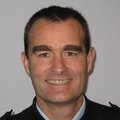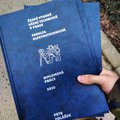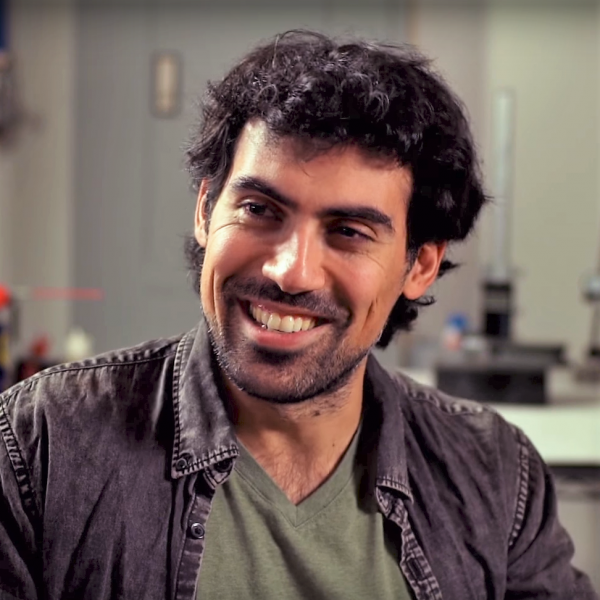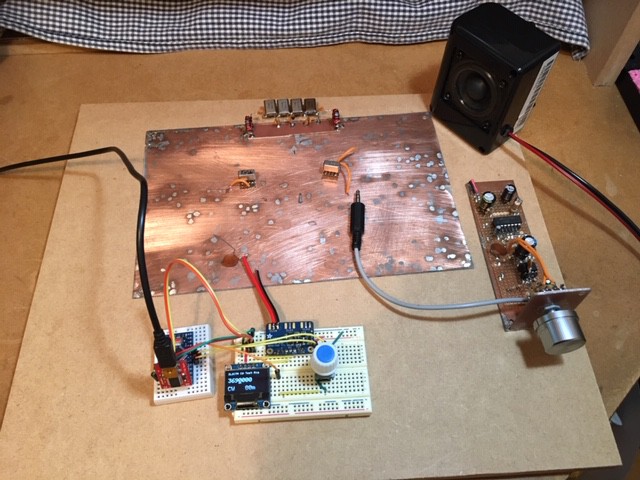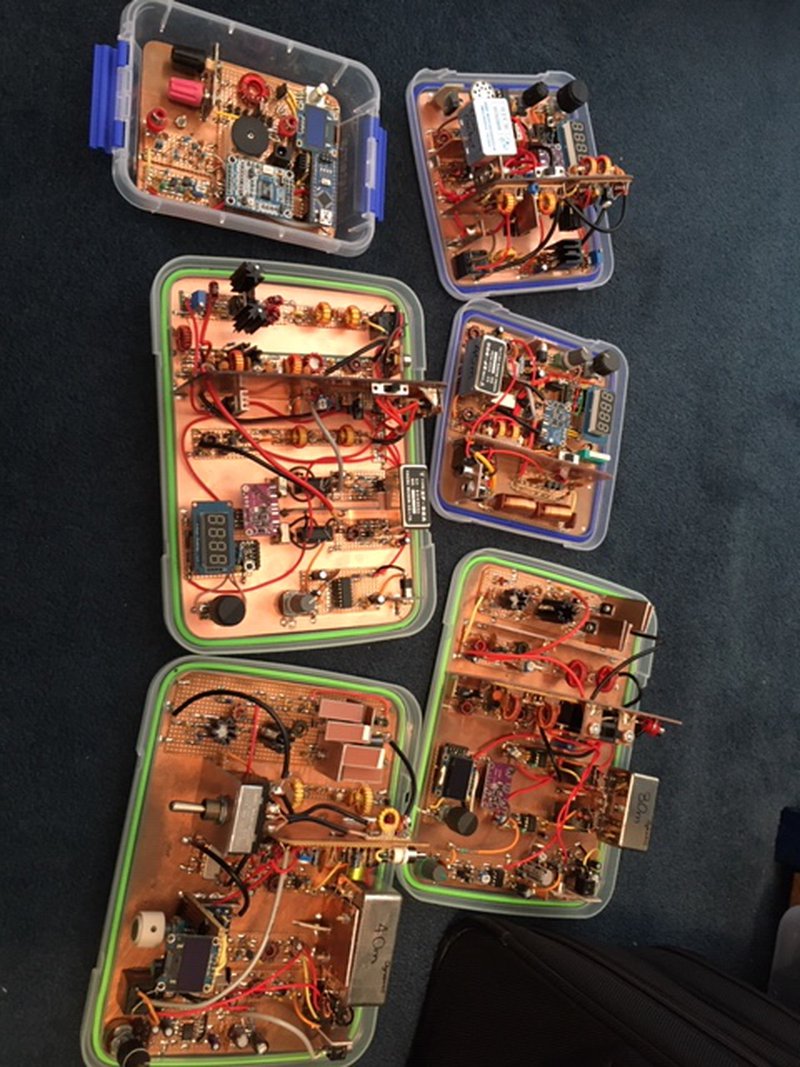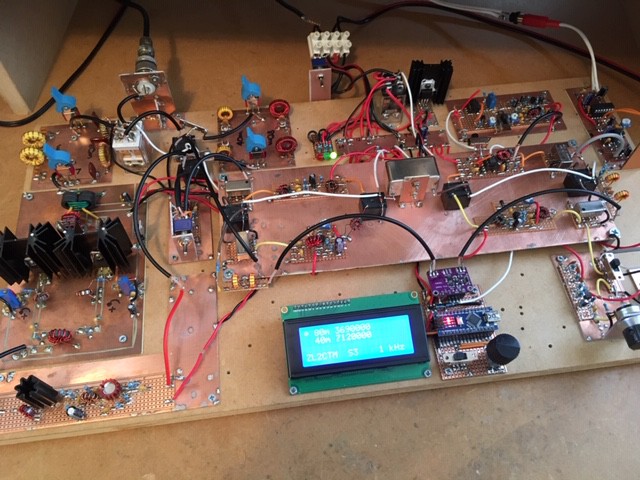-
Hack Chat Transcript, Part 3
03/18/2020 at 20:09 • 0 comments![]() I do reuse some stages, but more often than not I simply reuse the componts.
I do reuse some stages, but more often than not I simply reuse the componts.![]() Also, build the fittings jto support the pots, caps and switches using a 3d printer
Also, build the fittings jto support the pots, caps and switches using a 3d printer![]() I don't tend to box up my rigs as I like to see the electronics.
I don't tend to box up my rigs as I like to see the electronics.![]() @James Finch - Aren't you tuck with FSK and OOK with the Si4432? IOW, no AM, SSB, or FM?
@James Finch - Aren't you tuck with FSK and OOK with the Si4432? IOW, no AM, SSB, or FM?![]() *stuck
*stuck![]() Anyone played with the Teensy?
Anyone played with the Teensy?![]() Great little uPs. Very powerful.
Great little uPs. Very powerful.![]() Everytime I start with a box on a build I end up in a corner with lack of space or trying to trouble shoot down in a hole
Everytime I start with a box on a build I end up in a corner with lack of space or trying to trouble shoot down in a hole![]() @Charlie Morris ZL2CTM - I have one in a half-built virtual subtractive synth on a shelf :)
@Charlie Morris ZL2CTM - I have one in a half-built virtual subtractive synth on a shelf :)![]() started to when you were playing with SDR
started to when you were playing with SDR![]() @Charlie Morris ZL2CTM I've been using teensys for a few years, great devices! haven't had a chance to play with the 4 yet but I have one at home
@Charlie Morris ZL2CTM I've been using teensys for a few years, great devices! haven't had a chance to play with the 4 yet but I have one at home![]() Nice. They did a great job with that. The audio lib is really good too.
Nice. They did a great job with that. The audio lib is really good too.![]() @MS-BOSS I've been trying to be patient and wait and see what everyone else has done first. tinySA (HBTE groups.io), UHF Spectrum Analyzer (instructables) and the Hackaday.io https://hackaday.io/project/2443-handheld-3ghz-spectrum-analyzer
@MS-BOSS I've been trying to be patient and wait and see what everyone else has done first. tinySA (HBTE groups.io), UHF Spectrum Analyzer (instructables) and the Hackaday.io https://hackaday.io/project/2443-handheld-3ghz-spectrum-analyzer![]() have you ever tried building software selectable filters, charlie? either with fets or relays
have you ever tried building software selectable filters, charlie? either with fets or relays![]() The other hard part being here in NZ is getting components. I often have to ship them in from overseas, Especially toroids.
The other hard part being here in NZ is getting components. I often have to ship them in from overseas, Especially toroids.![]() I suspect that we're all about to face that Charlie
I suspect that we're all about to face that Charlie![]() Yes. I did use some relays a while back to sw in and out caps for a BPF. It worked. I want to do it again for a 80/40m rug.
Yes. I did use some relays a while back to sw in and out caps for a BPF. It worked. I want to do it again for a 80/40m rug.![]() I kept the inductance the same and varied the cap. The passband characteristics were a bit wonky, but it worked.
I kept the inductance the same and varied the cap. The passband characteristics were a bit wonky, but it worked.![]() Usually, a better approach than relays are PIN diode switches. At least these days.
Usually, a better approach than relays are PIN diode switches. At least these days.![]() Are there special considerations in sending RF through relay contacts?
Are there special considerations in sending RF through relay contacts?![]() @Charlie Morris ZL2CTM Do you have a known god aliexpress supplier of toroids?
@Charlie Morris ZL2CTM Do you have a known god aliexpress supplier of toroids?![]() @Dan Maloney Still researching and compiling resource data. Have to review the code to understnd.
@Dan Maloney Still researching and compiling resource data. Have to review the code to understnd.![]() @Dan Maloney You don't want to send more than a few watts through relay at the moment it is trying to disconnect the contacts. Then you get a lot of magic smoke.
@Dan Maloney You don't want to send more than a few watts through relay at the moment it is trying to disconnect the contacts. Then you get a lot of magic smoke.![]() For low level RF i have not had any problems with small relays. For high power yes. I tend to use either salvaged HF radio ant relays, or high current AC/DC relays. I havn't burned any contacts out with that approach.
For low level RF i have not had any problems with small relays. For high power yes. I tend to use either salvaged HF radio ant relays, or high current AC/DC relays. I havn't burned any contacts out with that approach.![]() @Dan Maloney For long operating life, cut the output power before switching the relay.
@Dan Maloney For long operating life, cut the output power before switching the relay.![]() Magic smoke. The key to everyhting.
Magic smoke. The key to everyhting.![]() I get my toriods form Kits and Parts
I get my toriods form Kits and Parts![]() @Dan Maloney Hermetically sealed relays with vaccuum inside are the best, however I have not seen them in years. At least not with sane price.
@Dan Maloney Hermetically sealed relays with vaccuum inside are the best, however I have not seen them in years. At least not with sane price.![]() @James Finch -Seemed to me when I read Silicon Labs data sheets on those chips is that they're geared mostly for transmitting and receiving data. They do make a line of FM broadcast receivers that output analog audio, but they're limited to the broadcast band 88.1-108MHz here in the States)
@James Finch -Seemed to me when I read Silicon Labs data sheets on those chips is that they're geared mostly for transmitting and receiving data. They do make a line of FM broadcast receivers that output analog audio, but they're limited to the broadcast band 88.1-108MHz here in the States)![]() As for AliExpress. I don't have any one specific supplier. I have been burned buying IRF510s. I only buy those through a local supplier.
As for AliExpress. I don't have any one specific supplier. I have been burned buying IRF510s. I only buy those through a local supplier.![]() @MS-BOSS - Thanks for the tips!
@MS-BOSS - Thanks for the tips!![]() I got a SPDT RF relay with SMA connectors from a ham fest earlier this year. Going to use it for a TX/RX relay with my LimeSDR Mini. Depending on its power level.
I got a SPDT RF relay with SMA connectors from a ham fest earlier this year. Going to use it for a TX/RX relay with my LimeSDR Mini. Depending on its power level.![]() Are the transitor and diode switches worse at HF? Guessing the RF switch IC's are a lower power option.
Are the transitor and diode switches worse at HF? Guessing the RF switch IC's are a lower power option.![]() See the photo above for the relays. All the blacl ones are 1A 30VDC
See the photo above for the relays. All the blacl ones are 1A 30VDC![]() I'm starting to use more and more SMA connectors. Not sure what the max power rating is for them.
I'm starting to use more and more SMA connectors. Not sure what the max power rating is for them.![]() GAN fets may be useful RF switches now. They are very cheap for very high currents and voltages, but have lots of gate leakage current. I have just started looking into them. Spiteful bumped die packages but.
GAN fets may be useful RF switches now. They are very cheap for very high currents and voltages, but have lots of gate leakage current. I have just started looking into them. Spiteful bumped die packages but.![]() @James Finch Even cheap PE4259 can handle +33.5 dBm into 50 Ohm load. Depends on your view of lower power.
@James Finch Even cheap PE4259 can handle +33.5 dBm into 50 Ohm load. Depends on your view of lower power.![]() I'm mostly QRP, so 5W or so out of the PA.
I'm mostly QRP, so 5W or so out of the PA.![]() I hope I am answering your quesitons.
I hope I am answering your quesitons.![]() @Dan Moloney Si443x (Si4431 is a little weaker TX signal): https://www.silabs.com/documents/public/data-sheets/Si4430-31-32.pdf
@Dan Moloney Si443x (Si4431 is a little weaker TX signal): https://www.silabs.com/documents/public/data-sheets/Si4430-31-32.pdf![]() We're getting up to the end of the hours, and although Charlie has the day off, we can't keep him away from the bench all day. I just want to say thanks to Charlie for getting up with the sun and spending his morning with us. I found this super useful, and I can't wait to try out some homebrew stuff myself.
We're getting up to the end of the hours, and although Charlie has the day off, we can't keep him away from the bench all day. I just want to say thanks to Charlie for getting up with the sun and spending his morning with us. I found this super useful, and I can't wait to try out some homebrew stuff myself.Thanks Charlie! 73 de N7DPM, and thanks to everyone how made this a great chat today!
![]() Thanks!
Thanks!![]() many thanks Charlie - very much appreciated
many thanks Charlie - very much appreciated![]() Thank you!
Thank you!![]() Thanks for the chat.
Thanks for the chat.![]() Thanks, Charlie.
Thanks, Charlie.![]() My pleasure.
My pleasure.![]() Don't forget that next week we'll be talking with Samy Kamkar about side-channel attacks and reverse engineering:
Don't forget that next week we'll be talking with Samy Kamkar about side-channel attacks and reverse engineering:![]() @Charlie Morris ZL2CTM power rating depends on the brand and type...here's an example https://mpd.southwestmicrowave.com/wp-content/uploads/2019/01/power-rating.pdf
@Charlie Morris ZL2CTM power rating depends on the brand and type...here's an example https://mpd.southwestmicrowave.com/wp-content/uploads/2019/01/power-rating.pdf![]()
https://hackaday.io/event/170293-side-channel-attacks-hack-chat
Side-Channel Attacks Hack Chat
Samy Kamkar Wednesday, March 25, 2020 12:00 pm PDT Local time zone: Hack Chat This event was created on 03/09/2020 and last updated a day ago. Join this event's team Samy Kamkar will host the Hack Chat on Wednesday, March 25, 2020 at noon Pacific Time. Time zones got you down?
![]() Thanks Trevor.
Thanks Trevor.![]() Feel free to stay on and chat, of course. The Hack Chat never closes!
Feel free to stay on and chat, of course. The Hack Chat never closes!![]() I'm here.
I'm here.![]() ah cool, you should make sure it's posted on the frontpage again next tuesday so i don't forgot
ah cool, you should make sure it's posted on the frontpage again next tuesday so i don't forgot![]() thanks charlie, i do enjoy your videos
thanks charlie, i do enjoy your videos![]() Charlie, really appreciate those videos where you explain how you get to the values that you do !1
Charlie, really appreciate those videos where you explain how you get to the values that you do !1![]() Thanks. I hope they are useful.
Thanks. I hope they are useful.![]() For sure! Enabled envisioning in more detail what those block diagrams are doing. Same with the IC's that perform those roles. Thanks Charlie!
For sure! Enabled envisioning in more detail what those block diagrams are doing. Same with the IC's that perform those roles. Thanks Charlie!![]() I know the circuits are super simple, but that's what I am trying to do. I want others to see that it's not hard.
I know the circuits are super simple, but that's what I am trying to do. I want others to see that it's not hard.![]() Yep, we run a post for the upcoming Hack Chat on Monday (usually) or Tuesday, and flog it in the newsletter that goes out Wednesday. I can also add you to the email reminder that goes out 30 minutes before the chat if you DM me your email address.
Yep, we run a post for the upcoming Hack Chat on Monday (usually) or Tuesday, and flog it in the newsletter that goes out Wednesday. I can also add you to the email reminder that goes out 30 minutes before the chat if you DM me your email address. -
Hack Chat Transcript, Part 2
03/18/2020 at 20:07 • 0 comments![]() Does that not come ith experience Charlie ... ?
Does that not come ith experience Charlie ... ?![]() I don't mind using other peoples circuits, but I need to understand how they work forst.
I don't mind using other peoples circuits, but I need to understand how they work forst.![]() That would be amazing.
That would be amazing.![]() MS-BOSS. That's true, but good for 80m-40m I suspect.
MS-BOSS. That's true, but good for 80m-40m I suspect.![]() Its informative to take a cap or an L and to try measuring it and understanding it - specially with more than one meter
Its informative to take a cap or an L and to try measuring it and understanding it - specially with more than one meter![]() Some older radios have the area's marked out with white lines and labels. So its easier to figrue out what does what.
Some older radios have the area's marked out with white lines and labels. So its easier to figrue out what does what.![]() What's that Juggle?
What's that Juggle?![]() understanding a circuit properly
understanding a circuit properly![]() yeah, i'd like to see some well documented impedance matching amplifiers that don't need transformers, like an IF amp that matches 50 ohm out of a mixer to 500 ohm crystal filter
yeah, i'd like to see some well documented impedance matching amplifiers that don't need transformers, like an IF amp that matches 50 ohm out of a mixer to 500 ohm crystal filter![]() Anybody has experience in getting CE /FCC for radio module?
Anybody has experience in getting CE /FCC for radio module?![]() Yes. A lot of the HF manuals explain the circuit quite well.
Yes. A lot of the HF manuals explain the circuit quite well.![]() SPICE is your friend, especially if you can get S-parameters of components as well as transient model.
SPICE is your friend, especially if you can get S-parameters of components as well as transient model.![]() Juggle. Yes. I had a good foundation through the air force. The more you do the more you understand how the circuit works.
Juggle. Yes. I had a good foundation through the air force. The more you do the more you understand how the circuit works.![]() @David I need to read into the latest and greatest. I'm a decade or two behind... spent most my time on FTNIR et.al. Interesting what can be made with lab test equipment also and with and for less now days.
@David I need to read into the latest and greatest. I'm a decade or two behind... spent most my time on FTNIR et.al. Interesting what can be made with lab test equipment also and with and for less now days.![]() That's what I actually like best about Charlie's videos: here's the component, this is what it does, and here are the calculations that I used to figure out the value. Great stuff
That's what I actually like best about Charlie's videos: here's the component, this is what it does, and here are the calculations that I used to figure out the value. Great stuff![]() @Tomi Piriyev I ran a few RF modules through FCC.
@Tomi Piriyev I ran a few RF modules through FCC.![]() @Tomi Piriyev I suspect there probably isn't much experience with that here since the focus is homebrew which wouldn't require testing and cert
@Tomi Piriyev I suspect there probably isn't much experience with that here since the focus is homebrew which wouldn't require testing and cert![]() Again, my approach is to keep tings simple. I'm trying to provide a resource back to the community.
Again, my approach is to keep tings simple. I'm trying to provide a resource back to the community.![]() @Charlie Morris ZL2CTM - would David Rutledge's "The Electronics of Radio" fall into that for you? I think it is basically walking through the design of a Norcal 40.
@Charlie Morris ZL2CTM - would David Rutledge's "The Electronics of Radio" fall into that for you? I think it is basically walking through the design of a Norcal 40.![]() Yes, especially as a beginner, it's not like I know that measuring that component is gonna show me xyz. it's nice being able to read through (or watch) someone's thought process and why they landed on designing something a certain way
Yes, especially as a beginner, it's not like I know that measuring that component is gonna show me xyz. it's nice being able to read through (or watch) someone's thought process and why they landed on designing something a certain way![]() I hope I do that June. That's the aim.
I hope I do that June. That's the aim.![]() I know the radios are simple and not 'contest grade' but that's the point for me.
I know the radios are simple and not 'contest grade' but that's the point for me.![]() I'ver a got a CW rig on the go here.
I'ver a got a CW rig on the go here.![]() Contests are great test grounds for simple xmtrs :-).
Contests are great test grounds for simple xmtrs :-).![]() @Gary Sutcliffe i would like to get CE/FCC certification for my Lora module
@Gary Sutcliffe i would like to get CE/FCC certification for my Lora module![]()
![]() @Gary Sutcliffe i am wondering how long does it take and what price range?
@Gary Sutcliffe i am wondering how long does it take and what price range?![]() @James Finch https://pubmed.ncbi.nlm.nih.gov/28043004/
@James Finch https://pubmed.ncbi.nlm.nih.gov/28043004/![]() I'll build the receiver first and check out that HB filter
I'll build the receiver first and check out that HB filter![]() you can't beat bare copper and a hot soldering iron !!
you can't beat bare copper and a hot soldering iron !!![]() I need to get a better soldering iron. I can't get mine hot enough to solder to a bare copper panel.
I need to get a better soldering iron. I can't get mine hot enough to solder to a bare copper panel.![]() use pads or me-squares
use pads or me-squares![]() @James Finch there also nice paper on non-resonant amplifier and antenna design I could try and find for you
@James Finch there also nice paper on non-resonant amplifier and antenna design I could try and find for you![]() TIme wise is hard to say. You can easily knock out an amp in an evening. Cost is not too bad either, especially with AliExpress. Probably well under $100
TIme wise is hard to say. You can easily knock out an amp in an evening. Cost is not too bad either, especially with AliExpress. Probably well under $100![]() @KD9KCK pre-heat it
@KD9KCK pre-heat it![]() Hm use islands. Good idea.
Hm use islands. Good idea.![]() old fashioned bread boarding at its finest -
old fashioned bread boarding at its finest -![]() @Charlie Morris ZL2CTM - how much "stuff" do you have on hand vs ordering things for a project you have in mind?
@Charlie Morris ZL2CTM - how much "stuff" do you have on hand vs ordering things for a project you have in mind?![]() I have a nice Weller one here. Having a good tip is important too.
I have a nice Weller one here. Having a good tip is important too.![]() Those cheap ~$10 LCR-T4 Mega meters are nice to getting started for testing and matching components.
Those cheap ~$10 LCR-T4 Mega meters are nice to getting started for testing and matching components.![]() @KD9KCK put the pcb on an electric grill
@KD9KCK put the pcb on an electric grill![]() put a pad on the intersections of every wire on Charlies design and you're away :-)
put a pad on the intersections of every wire on Charlies design and you're away :-)![]() Mines an old RadioShack 30 watt iron.
Mines an old RadioShack 30 watt iron.![]() The copper board as a base works well for me. I have very few instability probs.
The copper board as a base works well for me. I have very few instability probs.![]() super glue the pads and you can pop them off with a sharp blade later
super glue the pads and you can pop them off with a sharp blade later![]() James. Yes. You don't need lab grade equip to get going.
James. Yes. You don't need lab grade equip to get going.![]() my next project (after an antenna) was gonna be a cw single paddle with copperclad pcb as the main parts... y'all making me think i should get a different soldering iron (ive never used copperclad pcb before)
my next project (after an antenna) was gonna be a cw single paddle with copperclad pcb as the main parts... y'all making me think i should get a different soldering iron (ive never used copperclad pcb before)![]() Super glue is very funny once you heat it up and get the nasty fumes in eyes.
Super glue is very funny once you heat it up and get the nasty fumes in eyes.![]() easy to see and tweak too and as Charlie says - stable
easy to see and tweak too and as Charlie says - stable![]() keep the glue the other side of the pad
keep the glue the other side of the pad![]() I had a simple (I htink) 30MHz scope. The LCR meter is an M4070
I had a simple (I htink) 30MHz scope. The LCR meter is an M4070![]() hot iron, small pad, fast joint glue stays cool
hot iron, small pad, fast joint glue stays cool![]() I also sandpaper down old copper boards and use them again. As per the photo.
I also sandpaper down old copper boards and use them again. As per the photo.![]() The M4070 is OK, however lacks the possibility to select test frequency.
The M4070 is OK, however lacks the possibility to select test frequency.![]() @David Sure, thanks for the link. Great to see... interesting what can be analyzed using the RF range under the right conditions.
@David Sure, thanks for the link. Great to see... interesting what can be analyzed using the RF range under the right conditions.![]() Agreed.
Agreed.![]() I second having a good solder tip. Use a brass sponge to clean them instead of a wet sponge so your tip lasts longer.
I second having a good solder tip. Use a brass sponge to clean them instead of a wet sponge so your tip lasts longer.![]() If you've got a non-temp controlled iran, do yourself a favor and pickup an inexpensive one...there are Hakko knockoffs on aliexpress/ebay which work with genuine Hakko tips and they are probably $20 or so
If you've got a non-temp controlled iran, do yourself a favor and pickup an inexpensive one...there are Hakko knockoffs on aliexpress/ebay which work with genuine Hakko tips and they are probably $20 or so![]() A sponge for washing dishes and a bit of detergent does the same job without peeling of as much copper.
A sponge for washing dishes and a bit of detergent does the same job without peeling of as much copper.![]() A paper towel doesn't peel copper or reduce the tip temperature.
A paper towel doesn't peel copper or reduce the tip temperature.![]() Anyone have a BITX?
Anyone have a BITX?![]() yup
yup![]() I have a uBitx
I have a uBitx![]() That's another way to get into HF.
That's another way to get into HF.![]() I use it for SOTA
I use it for SOTA![]() yeah, the $40 898 with hotair and temp solder is pretty good for $40
yeah, the $40 898 with hotair and temp solder is pretty good for $40![]() yep, two of them
yep, two of them![]() I was thinking of getting a uBitx. Looks like it would be a nice radio.
I was thinking of getting a uBitx. Looks like it would be a nice radio.![]() I think they are good platform to experiment with. Not too expensive.
I think they are good platform to experiment with. Not too expensive.![]() Charlie, you're a rare beast, you build AND operate, many do one or the other !!
Charlie, you're a rare beast, you build AND operate, many do one or the other !!![]() I also think a DSB DC rig is a good starting point too. I started with that and then went to SSB.
I also think a DSB DC rig is a good starting point too. I started with that and then went to SSB.![]() it's an ok radio but it's open hardware and quite hackable...you'll prob want to add RF chokes to the digital lines, replace the pot and encoder, and add an AGC circuit
it's an ok radio but it's open hardware and quite hackable...you'll prob want to add RF chokes to the digital lines, replace the pot and encoder, and add an AGC circuit![]() No point biting off too much at the beginning and getting frustrated.
No point biting off too much at the beginning and getting frustrated.![]() I also modified mine to add a LiPo charge controller (pre-built) so I can perm install batteries for outdoor operation
I also modified mine to add a LiPo charge controller (pre-built) so I can perm install batteries for outdoor operation![]() That it Trevor. Buy the base radio and hack it. That way you will start to learn what is going on.
That it Trevor. Buy the base radio and hack it. That way you will start to learn what is going on.![]() my ubitx has all sorts of wires and bodge solders going on now. but i pretty much quit using it after buying an old kenwood at a hamfest
my ubitx has all sorts of wires and bodge solders going on now. but i pretty much quit using it after buying an old kenwood at a hamfest![]() Charlie, I really like your design and build technique, out in the open where eveny thing can be seen.
Charlie, I really like your design and build technique, out in the open where eveny thing can be seen.![]() thats the other cheap easy way in - old kit from rallies etc
thats the other cheap easy way in - old kit from rallies etc![]() Juggie. I probably build more than operate. I like tramping/hiking so making small radios is enjoyable.
Juggie. I probably build more than operate. I like tramping/hiking so making small radios is enjoyable.![]() hence the light waterproof form factor I guess
hence the light waterproof form factor I guess![]() I'll upload a pic soon.
I'll upload a pic soon.![]() |}{|
|}{|![]()
![]() These are all built in plastic boxes.
These are all built in plastic boxes.![]() Are those tupperware lids?
Are those tupperware lids?![]() So many food containers...
So many food containers...![]() Awesome!
Awesome!![]() The vertical copper pieces - are those to isolate signals, or to fit more in the space?
The vertical copper pieces - are those to isolate signals, or to fit more in the space?![]() It's a local brand herem but essentially the same.
It's a local brand herem but essentially the same.![]() They are built into the lids. The bottom is only attached for transport.
They are built into the lids. The bottom is only attached for transport.![]() I think the fine tuning of lab test equipment is what inspired me to just use that gear until I wanted smaller form factors for mobile and HT use. The price and noise floor of spectrum analyzers has me focused on building those.
I think the fine tuning of lab test equipment is what inspired me to just use that gear until I wanted smaller form factors for mobile and HT use. The price and noise floor of spectrum analyzers has me focused on building those.![]() Very nice pieces of kit!
Very nice pieces of kit!![]() Both. Thet separate the TX and RX and provide more room to mount boards.
Both. Thet separate the TX and RX and provide more room to mount boards.![]() Do you find you need the TX/RX separation? (ie, do you notice if that isn't there?)
Do you find you need the TX/RX separation? (ie, do you notice if that isn't there?)![]() Hardcore kit porn! Awesome!
Hardcore kit porn! Awesome!![]() So far all my homebrew has the TX and RX are separated because it is spread all across the workbench
So far all my homebrew has the TX and RX are separated because it is spread all across the workbench![]() hi
hi![]() I just do it. My approach is always to separate the high power TX rx from earlier amp stages. Less likely to have onscillations/instability.
I just do it. My approach is always to separate the high power TX rx from earlier amp stages. Less likely to have onscillations/instability.![]() I have had that on the base rigs.
I have had that on the base rigs.![]() The stripboard works well too for me.
The stripboard works well too for me.![]() I like the modular approach but with it on one board - less chance of ground loops
I like the modular approach but with it on one board - less chance of ground loops![]() Here's another one
Here's another one![]() Anyone using the Si4432 or thoughts regarding? They're so cost effective: https://www.ebay.com/itm/1PCS-Mini-SI4432-Remote-Wireless-Transceiver-Communication-Module-240MHZ-930MHZ/183413464917
Anyone using the Si4432 or thoughts regarding? They're so cost effective: https://www.ebay.com/itm/1PCS-Mini-SI4432-Remote-Wireless-Transceiver-Communication-Module-240MHZ-930MHZ/183413464917![]()
![]() Real Ham Radio!
Real Ham Radio!![]() Again. Build each stage individually and test it. Then combine then.
Again. Build each stage individually and test it. Then combine then.![]() where do you put all your mdf boards with radios on them? :)
where do you put all your mdf boards with radios on them? :)![]() When breadboard were breadboards!
When breadboard were breadboards!![]() That way you get the satisfaction that everything is on track.
That way you get the satisfaction that everything is on track.![]() reusable modules for later raios ...
reusable modules for later raios ...![]() @James Finch Have a look at the 128 registers you need to configure before you can use the radio.
@James Finch Have a look at the 128 registers you need to configure before you can use the radio.![]() bIOOp. Yes, on a shelf next to the desk. I can count three up there.
bIOOp. Yes, on a shelf next to the desk. I can count three up there.![]() I use the back side of floor planking - good size and stiff
I use the back side of floor planking - good size and stiff![]() I do reuse some stages, but more often than not I simply reuse the componts.
I do reuse some stages, but more often than not I simply reuse the componts.![]() Also, build the fittings jto support the pots, caps and switches using a 3d printer
Also, build the fittings jto support the pots, caps and switches using a 3d printer![]()
Hack Chat Transcript, Part 1
03/18/2020 at 20:06 • 0 commentsWow, huge turnout today! Thanks everyone for coming to the Hack Chat! I'm really excited to welcome Charlie Morris (ZL2CTM) to the chat. I've been following his YouTube channel on homebrewing for a while, and I'm excited to learn all about the art of building your own gear.
Thanks for getting up so early Charlie. Can you start us off with a little about yourself?
![]() Hallo
Hallo![]() Hi all. I got my licence back in 1990 while I was in the Air Force. I srarted as a Avionics tech then Engineer officer.
Hi all. I got my licence back in 1990 while I was in the Air Force. I srarted as a Avionics tech then Engineer officer.![]() The air force gave me a good grounding in electrionics.
The air force gave me a good grounding in electrionics.![]() I have loved all things electronics from a very young age. Switches, lights, motirs etc.
I have loved all things electronics from a very young age. Switches, lights, motirs etc.![]() After 30 yesrs of service, i'm now in the Ndew Zealand CAA
After 30 yesrs of service, i'm now in the Ndew Zealand CAA![]() Is there anyone else here who enjoys homebrew radios?
Is there anyone else here who enjoys homebrew radios?![]() hey charlie, K8TRC...watch all your videos..helps keep me moving on my own designs and despite not always being the ideal design methods, your techniques are well explained and generally work
hey charlie, K8TRC...watch all your videos..helps keep me moving on my own designs and despite not always being the ideal design methods, your techniques are well explained and generally work![]() yes & I follow your designs too
yes & I follow your designs too![]() dunno if i am proficient enough to say i enjoy it, i admire it
dunno if i am proficient enough to say i enjoy it, i admire it![]() Not yet as I'm still just studying for technician's license, but one day!!
Not yet as I'm still just studying for technician's license, but one day!!![]() @Charlie Morris ZL2CTM - I would guess quite a few of us. Me for one.
@Charlie Morris ZL2CTM - I would guess quite a few of us. Me for one.![]() I really rtry and keep the designs as simple as possible.
I really rtry and keep the designs as simple as possible.![]() curent HAM projects: GPS disciplined 10MHz clock, inexpensive 2m beacon for fox hunting, 6m ssb/ccw transceiver
curent HAM projects: GPS disciplined 10MHz clock, inexpensive 2m beacon for fox hunting, 6m ssb/ccw transceiver![]() What i cannot really find is the underlying theory (maths i guess) for many of the published circuits. That's what i really want.
What i cannot really find is the underlying theory (maths i guess) for many of the published circuits. That's what i really want.![]() WA6ARA here, yes, do a lot of building and also follow your videos
WA6ARA here, yes, do a lot of building and also follow your videos![]() Yes, GPS units for NZD2-5 is a great way to start.
Yes, GPS units for NZD2-5 is a great way to start.![]() More kits than building from scratch, but would like to reverse that.
More kits than building from scratch, but would like to reverse that.![]() Working on several pieces of test gear
Working on several pieces of test gear![]() your math breakdowns of circuits are a real learning tool for me
your math breakdowns of circuits are a real learning tool for me![]() I have my license, but don't quite know what to do with it. I'm really curious to know what's possible for creating simple text-based systems that rely on CW bands (I don't know Morse) or bands that have been set aside for digital comms.
I have my license, but don't quite know what to do with it. I'm really curious to know what's possible for creating simple text-based systems that rely on CW bands (I don't know Morse) or bands that have been set aside for digital comms.![]() Kits is a great way to start to see if you enjoy soldering. You acn then move into your own circuits.
Kits is a great way to start to see if you enjoy soldering. You acn then move into your own circuits.![]() @Charlie Morris ZL2CTM - What reference books you recommend for homebrew radio designers? I have an ARRL handbook and EMRFD, was wondering what you found useful.
@Charlie Morris ZL2CTM - What reference books you recommend for homebrew radio designers? I have an ARRL handbook and EMRFD, was wondering what you found useful.![]() Digital comms is exploding. There are som many types now that tyou should be able to find something that interests you. That the key.
Digital comms is exploding. There are som many types now that tyou should be able to find something that interests you. That the key.![]() RF electronics aren't that complicated unless one dives into designing really low noise circuits or tries to operate components near the borders of their stability regions.
RF electronics aren't that complicated unless one dives into designing really low noise circuits or tries to operate components near the borders of their stability regions.![]() I use Solid State Design for the Radio Amateur, Wes Hayward and Doug DeMaw, ARRL
I use Solid State Design for the Radio Amateur, Wes Hayward and Doug DeMaw, ARRLand
Experimental Methods in RF Design, Wes Hayward, Rick Campbell and Bob Larkin, ARRL
mainly.
![]() I am going to try my best to get onto 40m using a band-pass filter I built and my LimeSDR Mini. Also trying to make a WSPR decoder / encoder using a Teensy 4
I am going to try my best to get onto 40m using a band-pass filter I built and my LimeSDR Mini. Also trying to make a WSPR decoder / encoder using a Teensy 4![]() @Charlie Morris ZL2CTM .... are you experimenting with anything LoRa related at the moment?
@Charlie Morris ZL2CTM .... are you experimenting with anything LoRa related at the moment?![]() Both are good, but again lack the maths. I suspect a lot if is experimental and trial and error.
Both are good, but again lack the maths. I suspect a lot if is experimental and trial and error.![]() @Charlie Morris ZL2CTM any good recommendations on projects, books, or sites (other than your channel, which I just subscribed to) that could help someone get started with digital comms projects for amateur radio?
@Charlie Morris ZL2CTM any good recommendations on projects, books, or sites (other than your channel, which I just subscribed to) that could help someone get started with digital comms projects for amateur radio?![]() Working my way up the learning curve with some test equipment repairs/hacks to get started with so no unintentional emissions. Then some test equipment builds. Then I'll modify those for listening/monitoring with the other receivers and SDR's.
Working my way up the learning curve with some test equipment repairs/hacks to get started with so no unintentional emissions. Then some test equipment builds. Then I'll modify those for listening/monitoring with the other receivers and SDR's.![]() No not LoRA, but I have been reading into it. I tend to like things that have utility and I can use for something.
No not LoRA, but I have been reading into it. I tend to like things that have utility and I can use for something.![]() I'm also planning on building a very small, very low power FT4/FT8 device for 40/20m that I can keep in my pocket at all times
I'm also planning on building a very small, very low power FT4/FT8 device for 40/20m that I can keep in my pocket at all times![]() ^ That would be neat.
^ That would be neat.![]() Digital comms. There are some good channels on YouTube, but I must admit i cannot recall them now.
Digital comms. There are some good channels on YouTube, but I must admit i cannot recall them now.![]() probably will use a teensy 4 or maybe a small FPGA for the maths
probably will use a teensy 4 or maybe a small FPGA for the maths![]() FT8 is another interesting mode.
FT8 is another interesting mode.![]() @Charlie Morris ZL2CTM I believe you travel to the US relatively often for work? Are you ever on-air while here?
@Charlie Morris ZL2CTM I believe you travel to the US relatively often for work? Are you ever on-air while here?![]() The Teensy range is great, Very powerful and a great audio library. Especially for SDR
The Teensy range is great, Very powerful and a great audio library. Especially for SDR![]() i haven't watched all of your videos, charlie, but the ones I have seen you don't really talk about your antenna setup, and i see you always seem to be able to receive things even without much going on in the preselection filtering setup so i was wondering about what kind of antenna you have
i haven't watched all of your videos, charlie, but the ones I have seen you don't really talk about your antenna setup, and i see you always seem to be able to receive things even without much going on in the preselection filtering setup so i was wondering about what kind of antenna you have![]() Yea. Seems to be the only thing that really propagates on 6m recently.
Yea. Seems to be the only thing that really propagates on 6m recently.![]() @Charlie Morris ZL2CTM Cool, thanks! I'll search for them.
@Charlie Morris ZL2CTM Cool, thanks! I'll search for them.![]() this one of the best books I've found: Communications Receivers: DPS, Software Radios, and Design, 3rd Edition (McGraw-Hill Telecommunications) by Ulrich Rohde
this one of the best books I've found: Communications Receivers: DPS, Software Radios, and Design, 3rd Edition (McGraw-Hill Telecommunications) by Ulrich Rohde![]() @Charlie Morris ZL2CTM . Thanks. Application/use driven is really key for any project..... Its always interesting when "amateur radio" , "ham radio" and "maker" people approach projects differently either by trying to find a use for a specific technology or find a technology for a specific use case.
@Charlie Morris ZL2CTM . Thanks. Application/use driven is really key for any project..... Its always interesting when "amateur radio" , "ham radio" and "maker" people approach projects differently either by trying to find a use for a specific technology or find a technology for a specific use case.![]() Yes I do tavel to the states often for work. At this stage i have not looked at getting on air. That's probably a good idea though.
Yes I do tavel to the states often for work. At this stage i have not looked at getting on air. That's probably a good idea though.![]() Thanks Arthur. That looks interesting.
Thanks Arthur. That looks interesting.![]() I've actually found my previous attempts to get into building/making have fallen flat BECAUSE I didn't have a specific use I wanted to learn for. Ham radio has completely re-invigorated me wanting to hop into building again.
I've actually found my previous attempts to get into building/making have fallen flat BECAUSE I didn't have a specific use I wanted to learn for. Ham radio has completely re-invigorated me wanting to hop into building again.![]() AliExpress is also a great source for components. Just not BJTs and FETS!
AliExpress is also a great source for components. Just not BJTs and FETS!![]() I have had several of those blow up in my face.
I have had several of those blow up in my face.![]() I have been working on attempting to push a CB to 10m to get on the air.
I have been working on attempting to push a CB to 10m to get on the air.![]() I believe that asking about a book for "amateur radio" or "digital comms" are too broad questions and indicate that maybe you could grab some basic book like the art of electronics by Horowitz and Hill which is not specifically oriented at radio. Maybe if you were asking about specific issues like "balanced mixers", "demodulation techniques for FM", you could get a specific answer.
I believe that asking about a book for "amateur radio" or "digital comms" are too broad questions and indicate that maybe you could grab some basic book like the art of electronics by Horowitz and Hill which is not specifically oriented at radio. Maybe if you were asking about specific issues like "balanced mixers", "demodulation techniques for FM", you could get a specific answer.![]() Remember all - I'll post a transcript of the entire chat soon after we wrap up. No need to scramble to copy down links and such.
Remember all - I'll post a transcript of the entire chat soon after we wrap up. No need to scramble to copy down links and such.![]() June. That;'s the key. find something that interests you and get into it. Ham radio has so much to offer in that regard
June. That;'s the key. find something that interests you and get into it. Ham radio has so much to offer in that regard![]() chilbill. How is that going?
chilbill. How is that going?![]() What is the topic for tonight?
What is the topic for tonight?![]() I have a couple of old marine radios here that I have transplanted Si5351s into. They work well.
I have a couple of old marine radios here that I have transplanted Si5351s into. They work well.![]() that raises an interesting point about just getting an Si5351 working as a component ...
that raises an interesting point about just getting an Si5351 working as a component ...![]() @chibill - Love to hear details on that. I too was looking for an old SSB CB to convert, but the secondary market is pretty thin
@chibill - Love to hear details on that. I too was looking for an old SSB CB to convert, but the secondary market is pretty thin![]() oh!! lets talk about the Si5351...so many cool things you can do with that.
oh!! lets talk about the Si5351...so many cool things you can do with that.![]() then adding mixers and rf components, decent audio etc ...
then adding mixers and rf components, decent audio etc ...![]() I tend to use the Si5351 board with the I2C interface.
I tend to use the Si5351 board with the I2C interface.![]() @MS-BOSS - my specific thing I was currently looking at was around tweaking a class b, transformer coupled push-pull bjt qrp final PA. Any thoughts around a book for that?
@MS-BOSS - my specific thing I was currently looking at was around tweaking a class b, transformer coupled push-pull bjt qrp final PA. Any thoughts around a book for that?![]() First attempted sort of failed because I forgot to make sure the radio actually worked at first. Haven't started on the second try with a different radio. (This one had mods from someone else)
First attempted sort of failed because I forgot to make sure the radio actually worked at first. Haven't started on the second try with a different radio. (This one had mods from someone else)![]() @SimonAllen - Homebrewing ham radio
@SimonAllen - Homebrewing ham radio![]() A slight tip: Si5351s VCOs can be tuned from about 150-200 MHz to about 1100 MHz. In this range, the PLL works OK, although jitter may increase.
A slight tip: Si5351s VCOs can be tuned from about 150-200 MHz to about 1100 MHz. In this range, the PLL works OK, although jitter may increase.![]() Using si5351 to drive qrss xmtrs here.
Using si5351 to drive qrss xmtrs here.![]() if you into VHF/UHF then this is a classic: VHF-UHF Manual, by G.R. Jessop, published by Radio Society of Great Britain
if you into VHF/UHF then this is a classic: VHF-UHF Manual, by G.R. Jessop, published by Radio Society of Great Britain![]() @SimonAllen Charlie Morris who has a youtube channel and blogger with a lot of detailed designs he built and shows is on. https://www.youtube.com/channel/UCSNPW3_gzuMJcX_ErBZTv2g/videos
@SimonAllen Charlie Morris who has a youtube channel and blogger with a lot of detailed designs he built and shows is on. https://www.youtube.com/channel/UCSNPW3_gzuMJcX_ErBZTv2g/videos![]() Si5351 are very nice chips / devices. Mine doesn't seem to work well when feed with 3.3 volts.
Si5351 are very nice chips / devices. Mine doesn't seem to work well when feed with 3.3 volts.![]() you can make a WSPR beacon out of a Si5351.... This is a good example of something that take it to a different level.... https://www.qrp-labs.com/lightaprs-w.html
you can make a WSPR beacon out of a Si5351.... This is a good example of something that take it to a different level.... https://www.qrp-labs.com/lightaprs-w.html![]() Some great texts there. My main interest is HF for some reason. It's certainly easlier to design for.
Some great texts there. My main interest is HF for some reason. It's certainly easlier to design for.![]() Blogger: https://zl2ctm.blogspot.com/
Blogger: https://zl2ctm.blogspot.com/![]() @MS-BOSS - Does that mean you could use that chip to build a 2-m band FM receiver? Because I really need to do that.
@MS-BOSS - Does that mean you could use that chip to build a 2-m band FM receiver? Because I really need to do that.![]() @MS-BOSS That's fair, but I'm not too interested in digging too far into the theory. I'm looking for a basic starter project that someone could implement to start tinkering with digital comms over ham bands. Because I don't know much about amateur radio, I wouldn't even know what to ask when it comes to specific issues (at least until I start tinkering with some beginner project and started to learn more about it). It seems like watching people's builds on YouTube might be the way to go for that, as per Charlie's recommendation.
@MS-BOSS That's fair, but I'm not too interested in digging too far into the theory. I'm looking for a basic starter project that someone could implement to start tinkering with digital comms over ham bands. Because I don't know much about amateur radio, I wouldn't even know what to ask when it comes to specific issues (at least until I start tinkering with some beginner project and started to learn more about it). It seems like watching people's builds on YouTube might be the way to go for that, as per Charlie's recommendation.![]() Si5351 need to have properly decoupled power lines and crystal with low capacitance. See AN551
Si5351 need to have properly decoupled power lines and crystal with low capacitance. See AN551![]() Steve. I did that a while back with the AD9850. It worked really well. It just sits there doing its thing.
Steve. I did that a while back with the AD9850. It worked really well. It just sits there doing its thing.![]() Yes, you could... maybe. However, the Si5351 output is not guaranteed over 125 or 150 MHz, not sure right now
Yes, you could... maybe. However, the Si5351 output is not guaranteed over 125 or 150 MHz, not sure right now![]() That belies the hassle of getting a VFo working Charlie !!
That belies the hassle of getting a VFo working Charlie !!![]() However, be aware that it emits square wave
However, be aware that it emits square wave![]() Shawn. I'd get myself a radio and interface your computer to it.
Shawn. I'd get myself a radio and interface your computer to it.![]() @James Finch its 42. 58 mhz per esla
@James Finch its 42. 58 mhz per esla![]() I made an si5361 WSPR Beacon for 630 meters. Running about 12 W to a short 1% efficient antenna it has been picked up in Hawaii from here in Wisconsin – W9XT
I made an si5361 WSPR Beacon for 630 meters. Running about 12 W to a short 1% efficient antenna it has been picked up in Hawaii from here in Wisconsin – W9XT![]() Solid State Design for the Radio Amateur Paperback – great text for learning homebrewing.
Solid State Design for the Radio Amateur Paperback – great text for learning homebrewing.![]() Any thoughts of using the Si4432's? I suppose need two to mix to the diffrence frequency for lower range use.
Any thoughts of using the Si4432's? I suppose need two to mix to the diffrence frequency for lower range use.![]() @Dan Maloney 2m can be a little trickier to deal with as the frequency is high enough where you need to be careful about parasitic capacitance etc on your boards, but you can do it...there are a lot of components out there to make it much easier these days including VFOs
@Dan Maloney 2m can be a little trickier to deal with as the frequency is high enough where you need to be careful about parasitic capacitance etc on your boards, but you can do it...there are a lot of components out there to make it much easier these days including VFOs![]() Agreed. I stared many years ago with simple ocs and NO o'scope. Very hard to do.
Agreed. I stared many years ago with simple ocs and NO o'scope. Very hard to do.![]() However, you can use the Si5351 as 2m radio if you use some higher harmonic of the output which is utilized in NanoVNA.
However, you can use the Si5351 as 2m radio if you use some higher harmonic of the output which is utilized in NanoVNA.![]() @Trevor R.H. Clarke - Thanks!
@Trevor R.H. Clarke - Thanks!![]() Having a ok scope and sig gen are key for me here. Being able to see the signal/waveform is so important.
Having a ok scope and sig gen are key for me here. Being able to see the signal/waveform is so important.![]() You can build a pretty smooth field with permanent magnets up to about 1 tesla
You can build a pretty smooth field with permanent magnets up to about 1 tesla![]() The NanoVNA is another useful bit of kit. Quite cheap too.
The NanoVNA is another useful bit of kit. Quite cheap too.![]() I have a 20 Mhz o'scope and also a NanoVNA. No good sig gen. Was going to use my SI5351 as a sig gen for testing stuff.
I have a 20 Mhz o'scope and also a NanoVNA. No good sig gen. Was going to use my SI5351 as a sig gen for testing stuff.![]() That's usually small though
That's usually small though![]() Any links or tips for reprogramming the NanoVNA for other ham applications?
Any links or tips for reprogramming the NanoVNA for other ham applications?![]() lots of material on the NanoVNA around on the web - watch G-QRP for contributions from Tony G4WIF
lots of material on the NanoVNA around on the web - watch G-QRP for contributions from Tony G4WIF![]() I'd filter the Si5351 to make it a useful sig gen. I nice clean sinewave.
I'd filter the Si5351 to make it a useful sig gen. I nice clean sinewave.![]() Have a look at ADF4351 or MAX2870 for cheap microwave signal generators. Square wave, again.
Have a look at ADF4351 or MAX2870 for cheap microwave signal generators. Square wave, again.![]() @Charlie Morris ZL2CTM - are there any homebrewing resources that you wish existed?
@Charlie Morris ZL2CTM - are there any homebrewing resources that you wish existed?![]() I'm aiming for about 0.1-.2 Tesla, so somewhere between 4 and 8mhz
I'm aiming for about 0.1-.2 Tesla, so somewhere between 4 and 8mhz![]() I had the same question re the NanoVNA. The base software is good, but freq entry is lacking.
I had the same question re the NanoVNA. The base software is good, but freq entry is lacking.![]() But I'm not an RF guy
But I'm not an RF guy![]() @Charlie Morris ZL2CTM Good idea! I'll look at getting a rig for that. Thanks!
@Charlie Morris ZL2CTM Good idea! I'll look at getting a rig for that. Thanks!![]() Charlie Morris, what o'scope are you using?
Charlie Morris, what o'scope are you using?![]() I need fast switching gdrtom TX to RX
I need fast switching gdrtom TX to RX![]() @chibill if you can afford a little bit, there are lots of halfway decent sig gens using DDS you can pickup for well under $100 USD. They make decent sine and triangle waves which is important for a lot of applications. The si5351 generates a square so you'd need to do some filtering to use it as a sig gen
@chibill if you can afford a little bit, there are lots of halfway decent sig gens using DDS you can pickup for well under $100 USD. They make decent sine and triangle waves which is important for a lot of applications. The si5351 generates a square so you'd need to do some filtering to use it as a sig gen![]() anybody has experience getting CE certification for RF transiver?
anybody has experience getting CE certification for RF transiver?![]() If you filter the output of the Si5351 or other square wave generator, then you have tuning range less than 1:3, because then the higher harmonics get through the filter.
If you filter the output of the Si5351 or other square wave generator, then you have tuning range less than 1:3, because then the higher harmonics get through the filter.![]() Ben. Yes. I'd like more theory based resources. I love being able to see all of the components in a radio and know what each component does.
Ben. Yes. I'd like more theory based resources. I love being able to see all of the components in a radio and know what each component does.About Us Contact Hackaday.io Give Feedback Terms of Use Privacy Policy Hackaday API
 Lutetium
Lutetium